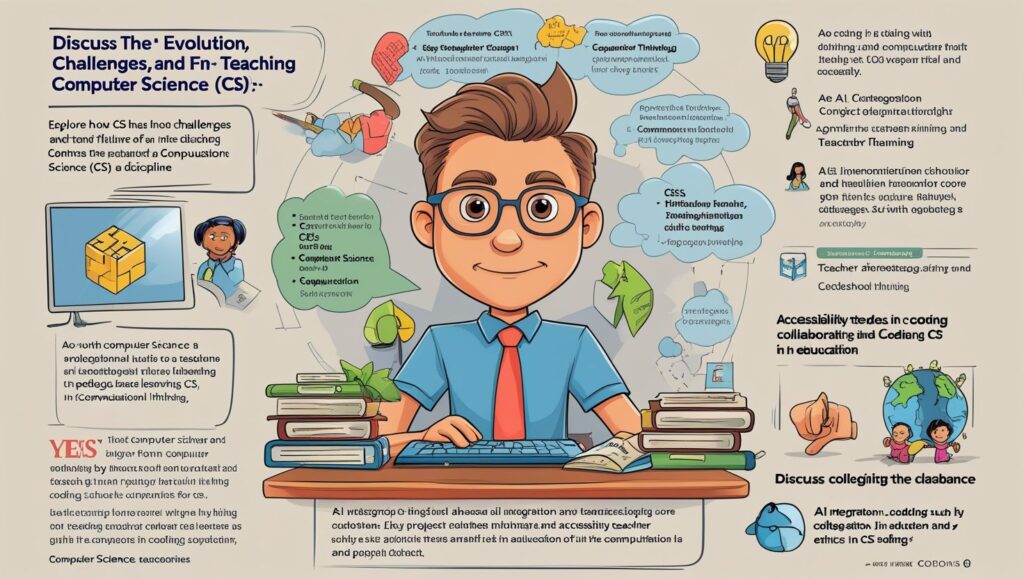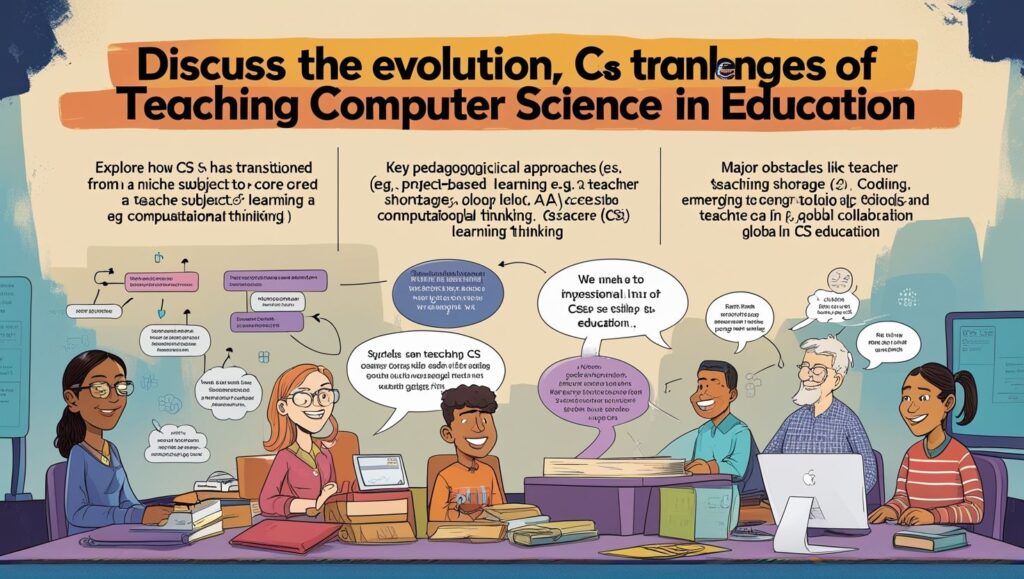Introduction
The Teaching of Computer Science in Education, Computer Science (CS) has become a cornerstone of modern education, shaping the way students think, solve problems, and interact with technology. Over the years, the teaching of CS has evolved from a niche subject to a fundamental discipline integrated into school curricula worldwide. This article explores the historical development of CS education, its pedagogical approaches, challenges faced, and future prospects in preparing students for a technology-driven world.
Historical Development of Computer Science Education
Early Beginnings (1960s–1980s)
The origins of CS education can be traced back to the 1960s when universities began offering programming and computational theory courses. Initially, computer science was limited to higher education, with a focus on mathematical algorithms and hardware systems. The introduction of personal computers in the 1980s, such as the Apple II and IBM PC, brought computing into schools, though primarily for basic programming (e.g., BASIC and Pascal) rather than comprehensive CS education.
Expansion in Schools (1990s–2000s)
By the 1990s, schools started incorporating computer literacy programs, teaching students how to use software like Microsoft Office. However, true CS education—covering programming, algorithms, and problem-solving—remained rare in K-12 settings. The rise of the internet in the late 1990s and early 2000s further emphasized the need for digital literacy, but structured CS curricula were still lacking in many countries.
Modern Era (2010s–Present)
The last decade has seen a global push to integrate CS into mainstream education. Governments and organizations, such as Code.org and the Computer Science Teachers Association (CSTA), have advocated for mandatory CS courses. Countries like the UK have introduced coding as part of the national curriculum, while the U.S. has seen increasing adoption of AP Computer Science courses in high schools. The focus has shifted from mere digital literacy to computational thinking, programming, and real-world applications like artificial intelligence (AI) and data science.

Pedagogical Approaches in Teaching Computer Science
Effective CS education requires innovative teaching methods that engage students and foster problem-solving skills. Some key pedagogical approaches include:
1. Hands-on, Project-Based Learning
Rather than relying solely on lectures, modern CS education emphasizes hands-on projects where students build programs, apps, or games. This approach enhances creativity and practical understanding. Tools like Scratch (for younger students) and Python (for advanced learners) facilitate experiential learning.
2. Computational Thinking
Coined by Seymour Papert and popularized by Jeannette Wing, computational thinking involves breaking down problems into logical steps—decomposition, pattern recognition, abstraction, and algorithmic thinking. This mindset is taught even before coding, helping students approach problems methodically.
3. Flipped Classrooms and Online Learning
With the growth of e-learning platforms (e.g., Khan Academy, Coursera), students can learn coding at their own pace. Flipped classrooms allow students to study theory online and use class time for collaborative coding exercises.
4. Interdisciplinary Integration
CS is increasingly taught alongside other subjects. For example:
- Math & Science: Using programming to solve equations or simulate experiments.
- Art & Design: Creating digital graphics or animations.
- Humanities: Analyzing data trends in history or social sciences.
5. Gamification and Competitions
Coding competitions (e.g., Google Code Jam, Hackathons) and gamified learning platforms (e.g., CodeCombat) motivate students by making learning fun and competitive.
Challenges in Teaching Computer Science
Despite progress, several obstacles hinder the widespread adoption and effectiveness of CS education:
1. Lack of Qualified Teachers
Many schools struggle to find educators with strong CS backgrounds. Teachers often require additional training, which can be costly and time-consuming.
2. Gender and Diversity Gaps
The concepts of gender and diversity have become increasingly significant in the modern global discourse. Societies today are marked by a rich mosaic of cultures, identities, and expressions. However, disparities continue to exist in terms of gender equity and inclusion of diverse groups across sectors such as education, employment, governance, and healthcare. Gender and diversity gaps represent systemic imbalances that hinder societal development, reinforce discrimination, and perpetuate inequality. Understanding the roots and implications of these gaps is crucial for promoting inclusive growth, social justice, and equal opportunity.
3. Unequal Access to Resources
Schools in low-income areas may lack computers, high-speed internet, or updated software, creating a digital divide.
4. Rapid Technological Changes
CS evolves quickly, making it challenging for curricula to stay current. Educators must continuously update their knowledge on topics like AI, cybersecurity, and blockchain.
5. Misconceptions About CS
Some students and parents view CS as overly complex or only for “geniuses,” discouraging early interest. Efforts are needed to demystify the subject and highlight its creative aspects.

The Future of Computer Science Education
As technology continues to shape society, CS education must adapt to prepare future generations. Key trends include:
1. Early Exposure (Elementary School)
Introducing computational thinking and basic coding in primary schools helps build foundational skills early. Countries like Estonia have successfully implemented this model.
2. AI and Machine Learning in Curriculum
With AI transforming industries, schools are beginning to teach machine learning concepts, ethics, and applications.
3. Emphasis on Ethics and Cybersecurity
As data privacy and cyber threats grow, teaching ethical hacking, digital citizenship, and responsible AI use will become essential.
4. Personalized and Adaptive Learning
AI-driven platforms can tailor lessons to individual student needs, improving engagement and retention.
5. Global Collaboration and Remote Learning
Online coding bootcamps and international collaborations (e.g., virtual hackathons) allow students to learn from global experts.
Conclusion
The teaching of Computer Science in education has come a long way, from being an optional skill to a critical component of modern learning. While challenges like teacher shortages and accessibility persist, innovative teaching methods and policy reforms are paving the way for a more inclusive and dynamic CS education landscape. As technology advances, schools must continue evolving their curricula to equip students with the skills needed for future careers. By fostering computational thinking, creativity, and ethical awareness, educators can ensure that the next generation thrives in an increasingly digital world.

Great post! I really enjoyed reading this. Your insights were clear and helpful — thanks for sharing!
I like the efforts you have put in this, thanks for all the great posts.
We’re a group of volunteers and starting a new scheme in our community. Your site offered us with valuable information to work on. You’ve done a formidable job and our entire community will be thankful to you.
I do love the manner in which you have framed this specific problem plus it does give me personally a lot of fodder for thought. However, from just what I have observed, I basically hope when the commentary pack on that people today continue to be on point and don’t embark on a soap box associated with the news du jour. Still, thank you for this excellent point and even though I do not necessarily agree with this in totality, I value your viewpoint.
My spouse and I stumbled over here from a different web address and thought I might check things out. I like what I see so i am just following you. Look forward to looking over your web page again.
Fantastic beat ! I would like to apprentice at the same time as you amend your website, how can i subscribe for a blog web site? The account aided me a applicable deal. I had been a little bit familiar of this your broadcast offered vivid transparent concept
After research a few of the weblog posts on your website now, and I really like your means of blogging. I bookmarked it to my bookmark website record and can be checking again soon. Pls try my website as effectively and let me know what you think.
Hi! Would you mind if I share your blog with my twitter group? There’s a lot of people that I think would really enjoy your content. Please let me know. Cheers
australian brewery poker, best deposit bonus uk how to hack coin master
and get free spins (Consuelo) new online casinos for real money usa,
or new zealandn original slot machine download
beste sportwetten app
my website: Internet wetten Live
live sportwetten strategie
Also visit my website :: wettbüro bonn; newsblogsite.bcbloggers.com,
online sportwetten app
my web site; live wetten bonus [Irwin]
best usa online casino real money, online usa real money schenectady gazette rivers casino [Almeda] and casino chips value uk, or best payout online slots australia
best online pokies united states casino, casino new south wales united states and online casino franchise uk,
or online casinos usa friendly
Feel free to visit my homepage … guaranteed win on roulette
bet365 roulette strategy usa, free spins no deposit casinos usa
and uk online casinos free play, or are there pokies in western new zealand
Here is my homepage :: The Niagara Falls casino
online wettanbieter vergleich
Feel free to surf to my web site: handicap wetten bwin (Marquis)
wettseiten geld verdienen mit sportwetten startguthaben
handicap wette erklärt
Also visit my website Sportwetten Tipps Profi
bester wettanbieter ohne oasis
my website wette deutschland schottland – Irish
–
online bonus sportwetten (Hulda) schweiz legal
buchmacher de
my web page quotenrechner kombiwette
wettanbieter ohne limit
Here is my page bonus wetten vergleich (https://getinto.online/sportwettenanbieter-deutschland-ungarn/)
wettbüro mannheim
Here is my blog: wettseiten [Johnette]
was ist handicap beim wetten
my blog post; online sportwetten
welche Schweizer Sportwetten sind in der schweiz legal
buchmacher online
Have a look at my site – Wettformat gratiswette (https://burger-lab-rest.Freesite.io)
beste wettanbieter deutschland
Feel free to visit my web page; alle sportwetten anbieter,
Maisie,